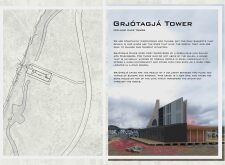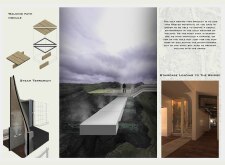5 key facts about this project
The Grjótgjá Tower is located in the Grjótgjá Caves in Iceland, a unique geological site where tectonic plates meet. The design aims to blend the cave's natural features with a space for people to gather. It focuses on providing warmth and comfort, transforming an uninviting area into an inviting retreat. The overall approach encourages exploration while respecting the environment.
Concept Integration
The design takes inspiration from the geological history of the caves, formed by the collision of European and American tectonic plates. This natural setting informs the architectural choices, ensuring the new structure both complements and enhances the local landscape. By focusing on the cave’s naturally avoided areas, the tower emerges as a new focal point that utilizes the steam escaping from the cave's crevices, shaping the experience of those who visit.
Pathway Implementation
A significant feature of the project is the Walking Path Module, which allows for safe movement through the cave system. This pathway connects various parts of the tower, making it easier for visitors to navigate the space. By encouraging exploration, the design invites people to experience the unique characteristics of the caves, fostering a connection to the environment.
Steam Utilization
The Steam Terrarium includes elements that harness the naturally occurring steam from the caves. This feature not only serves a practical purpose by providing warmth but also enhances the overall atmosphere. Through its design, the terrarium efficiently uses local resources, contributing to the comfort of the interior spaces. The staircase that leads to the bridge adds vertical movement, making it easy for visitors to access different levels of the tower and enjoy various viewpoints.
The thoughtful connection between natural elements and architectural design creates a unique setting that values both the cave's geology and user experience. Visitors can expect to engage with a space where the natural landscape is celebrated, resulting in a sense of harmony between the built environment and nature. The integration of pathways and steam features helps ensure a welcoming atmosphere that draws people into the experience.






















































